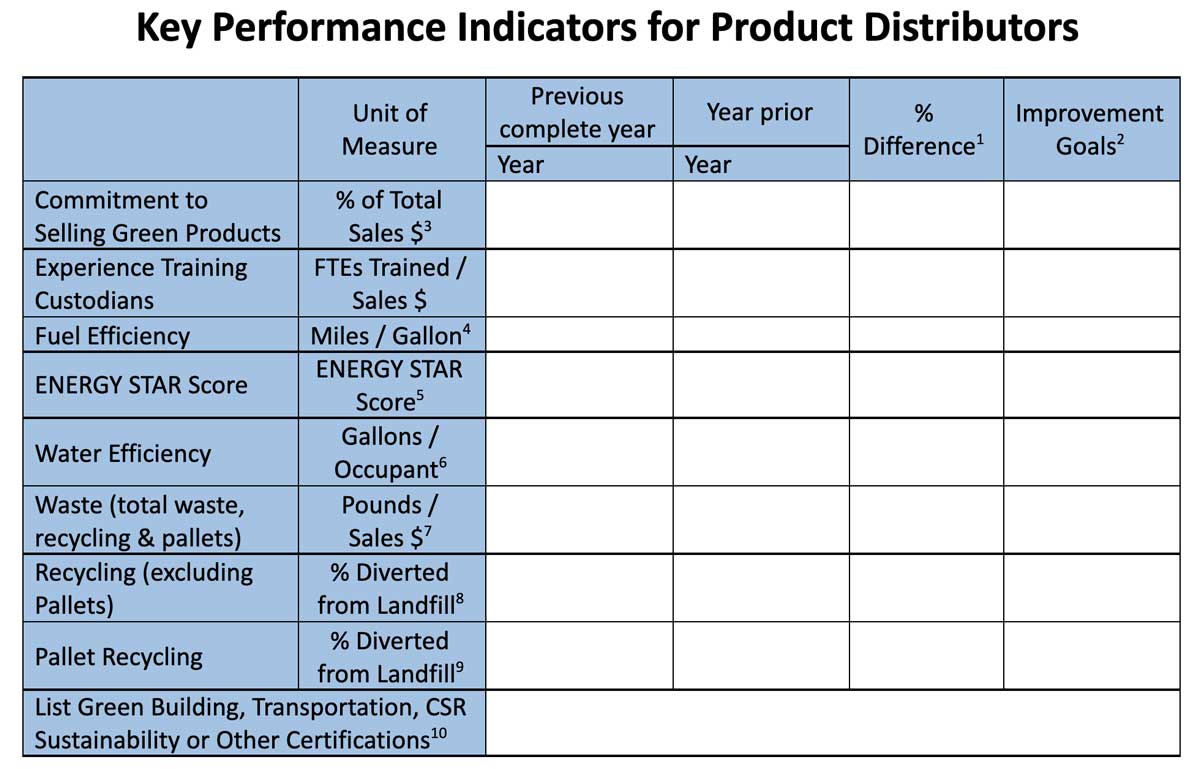
"We hear a lot from distributors whose customers are calculating their Scope 3 emissions, which simply refers to the customer's emissions from their supply chain," says Katrina Saucier, program manager at Green2Sustainable, Bloomington, Indiana. "For cleaning product distributors, it is the distributor's greenhouse gas emissions associated with handling and delivering the customer's products. The greatest impact on GHG emissions is from their delivery fleet."
Other important sustainability reporting metrics include energy for lighting, heating and cooling offices and warehouses, water use, waste and recycling, and the percent of green products sold.
The attached chart is a sustainability reporting scorecard for distributors. It identifies the key performance indicators, addresses improvement goals and measures performance against those goals. Using the simple scorecard will make it easier to respond to requests from customers and will also help distributors reduce their environmental footprint, which will in turn identify improvement opportunities that can lead to real bottom-line savings as they reduce their consumption of fuel, energy, water and waste.

Footnote explanations for using the chart are explained below:
1 — Calculate the percent difference by subtracting the previous complete year from the year prior and then dividing by the year prior. Then multiply this value by 100%.
2 — State improvement goals. This is typically a percentage. If no goals have been established, leave this blank.
3 — This is a measure of the distributor’s commitment to selling Green products. Calculate the total dollar value of Green products sold (define Green products by using the US Green Building Council’s LEED for Existing Buildings: Operations & Maintenance Rating System Version 4 guidelines for cleaning products) and divide by total sales dollars. Then multiply this value by 100%.
4 — This is a measure of fuel efficiency. Calculate the total number of miles driven by delivery and service vehicles and divide by the gallons of fuel consumed for all fuel types including diesel, gasoline, E10 and others used in delivery and service vehicles only (exclude sales vehicles). If third-party delivery companies are used, calculate the weighted miles per gallon of the delivery services based on the percentage of total dollars spent with each service.
5 — This is a measure of energy efficiency. Use ENERGY STAR Portfolio Manager for Buildings & Plants to calculate warehouse energy performance. https://www.energystar.gov/buildings/facility-owners-and-managers/existing-buildings/use-portfolio-manager
6 — This is a measure of water efficiency. Calculate the total gallons of water consumed including that used for drinking, landscaping, vehicle washing and other purposes (gallons) and divide by the number of FTEs working in the office and warehouse.
7 — This is a measure of waste minimization. Calculate the total waste in pounds per total sales dollars. If the waste hauler does not weigh the bin, calculate the weight for un-compacted waste at 73 pounds per cubic yard and compacted waste at 138 pounds per cubic yard. https://www.epa.gov/sites/production/files/2016-04/documents/volume_to_weight_conversion_factors_memorandum_04192016_508fnl.pdf
8 — This is a measure of waste diversion from landfills of internal consumables. Calculate the total amount of recycling including materials that are composted, donated, reused or otherwise diverted from the landfill and divide by the total amount of materials being disposed of, excluding pallets. Then multiply this value by 100%.
9 — This is a measure of waste diversion from landfills of durable goods. Calculate the total weight of pallets recycled, sold for third-party reprocessing or otherwise diverted from the landfill and divide by the total amount of pallets being disposed of. Then multiply this value by 100%.
10 — Include third party certifications such as LEED, WELL, ENERGY STAR, BOMA TOBY Award, SmartWay Transport, etc.
Stephen Ashkin is considered the "Father of Green Cleaning" and is now working to define sustainability for the global cleaning industry. He can be reached at Steve@AshkinGroup.com.
How Distributors Can Manage Sustainability Requests

 Celebrating BSCAI's 60th Anniversary eBook
Celebrating BSCAI's 60th Anniversary eBook The Down and Dirty on Cleaning in Virus Season
The Down and Dirty on Cleaning in Virus Season How Surfactant Use is Expanding in Commercial Cleaning
How Surfactant Use is Expanding in Commercial Cleaning